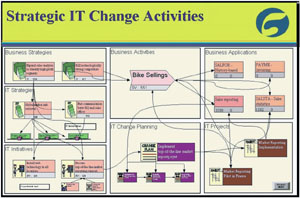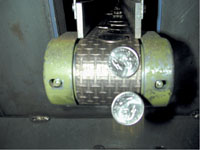Technology Forecasts Efficiencies
 |
Developed by Computas NA, the Metis planning and visualization tool permits managers to map enterprise architectures by laying out objects such as business processes and their relationships to each other. These interactions are displayed on a template showing the links between an organization and its information technology infrastructure. |
A commercial management and visualization software tool now permits organizations to assess the effect new applications will have on their existing systems quickly. Planners also can record modifications to the architecture in a data repository so changes and their effects can be studied and referenced.
Upgrading aging computer and communications infrastructure is an ongoing U.S. government effort. Spurred by legislation such as the Clinger-Cohen Act of 1996 and administrative initiatives such as the Office of Management and Budget’s (OMB’s) federal enterprise architecture mandate, government organizations are modernizing their systems and business processes. Commercial off-the-shelf (COTS) products play a vital role in this undertaking. By providing a rapidly accessible and cost-effective solution to older bespoken systems, commercial tools permit federal planners to meet their modernization goals quickly and efficiently.
An example of these efforts is the U.S. Mint’s ongoing enterprise architecture program. Responsible for manufacturing and circulating the nation’s coins, this Washington D.C.-based branch of the U.S. Treasury Department designed its new architecture to provide its business units with data in real time. COTS systems play a central role in this structure.
According to Tan Van Luong, the Mint’s chief enterprise architect, the program was under consideration for several years but did not officially launch until the spring of 2003. Work on a baseline capability began last March and ended in September. Luong notes that he currently is conducting gap analysis, implementation and assessment of the program life cycle. This first phase is scheduled for completion by September 2004, followed by the installation of systems for the organization’s individual business units. The full enterprise architecture will be operational by March 2005, he says.
COTS products are an important part of the program. “We do very little true information technology development work here. We’re basically an integration shop,” explains the Mint’s Chief Information Officer Jerry Horton. He offers that his philosophy is to buy commercial systems and implement and integrate them with as little additional development work as possible. The Mint is using products by IBM to run its e-commerce operations and by PeopleSoft for enterprise resource planning.
But the primary COTS tool in the Mint’s new enterprise architecture is Metis, which permits managers to access data and visualize how different systems interact. Developed by Computas NA Incorporated, Sammamish, Washington, it is an integrated set of client and server tools using Internet-based technology such as extensible markup language to create, visualize, modify, share and manage data models. The software provides development templates that comply with standard formats for enterprise architectures. “We use Metis because it can tell users the relationship between an artifact or an object in the business process. In case we need to move or add another artifact or model, we are able to see the relationship and its impact on other objects and models,” Luong says.
Horton believes Metis has streamlined the process of installing new software by allowing planners to see the systems they have available. Prior to installing Metis, Mint administrators did not have a very good view of all of their applications. “Now we have that architecture, that inventory of systems so we can also see where the data flows are coming and going—especially as they relate to manufacturing. There is a lot of data flow on the production floors that we can model inside the tool and then start to look at e-commerce applications for sales and marketing,” he says.
Metis also provides a data repository that can be accessed by all of the business units for their daily operations. It is already in use with the Mint’s sales and marketing operations. Luong notes that to date the repository has saved the bureau approximately $20 million by streamlining risk assessments for business cases that it is required to report to the OMB. When the assessments are stored in one place, they can be accessed easily for study and reference.
Another related part of the Metis software is an application portfolio containing information about all of the organization’s business systems. During the initial planning development stages for the Mint’s enterprise architecture, the tool permitted developers to choose which aspects of the Treasury Department’s enterprise architecture framework to use. Currently, Metis increases access to the business case portfolios the Mint must provide to the OMB. In the past, it was difficult to work through different business units’ systems to collect information, but the central repository now allows data to be stored easily and retrieved, he says.
 |
 |
Metis software has helped to streamline operations at the U.S. Mint. According to Jerry Horton, chief information officer for the Mint, it permits planners to visualize and track inventory and data flows for areas such as manufacturing. |
Metis is a useful tool for strategic planning for aspects such as impact analysis, says McNabb. As business processes change, it will highlight impacted areas. “Not only do we have the hierarchy decomposition of the processes, but we also have their interrelationships with all of the other models. If I’ve got a business process, I know it is associated with the human resources application, which is composed of these technology components. The actual linkages to the other models are all captured within that model,” he explains.
Since its launch, the enterprise architecture has already increased efficiencies. Horton notes that it serves as one of many types of lenses with which to view data. Work is underway to integrate capital planning processes and asset management into this framework. The structure also makes it easier for planners to determine where and when to purchase new systems. He adds that the enterprise architecture has helped the bureau consolidate many of its servers and remove other redundancies. A decade ago, the Mint’s field sites operated as individual organizations, each with its own separate computer system, but consolidation has increased efficiencies. For example, combining servers at one of the Mint’s facilities will save roughly $100,000 per year in maintenance, support and inventory costs, Horton says.
During the establishment of the enterprise architecture program, the two primary challenges the Mint faced were building relationships between its various business units and securing the right resources to complete the job. Horton notes that Metis was a very useful tool in convincing the business units to use the enterprise architecture. The Mint also was able to install and implement it with very little development work.
The Mint has two primary business units, a manufacturing and circulation branch and a numismatic operation that markets and sells coins to collectors. It also produces silver, gold and platinum bullion coins for collectors and as financial investments, Horton explains, noting that some 11 billion coins were produced and put into circulation in 2003. Coins are sold through the Mint’s Web site, which carries about 43 percent of the organization’s marketing, he says.
Both the manufacturing and sales divisions of the Mint volunteered skilled personnel to serve on an advisory task force to plan the architecture. The business units also explained their business processes to the development team. An unintended benefit of this was that the sales and marketing branches had their business processes diagramed for the first time through Metis. “They’d never really had it all mapped out so they could see where every process was. Once you could see where the redundancies were, where the excess steps were, it was easy to start to consolidate and reduce the overall cost and complexity,” Horton says.
Although it is too early to measure any return on investment, Horton believes that the efficiencies provided by the enterprise architecture will begin to bear fruit in 2004 or 2005. Some benefits have already become apparent. For example, during the mapping of business processes for the architecture, the Mint was able to meet and resolve a major auditing issue. The organization also saved roughly $1 million by eliminating some process steps and smoothing out inventory issues.
Additional information on the U.S. Mint and Computas NA is available on the World Wide Web at http://www.usmint.gov and http://www.computas.com.




Comments